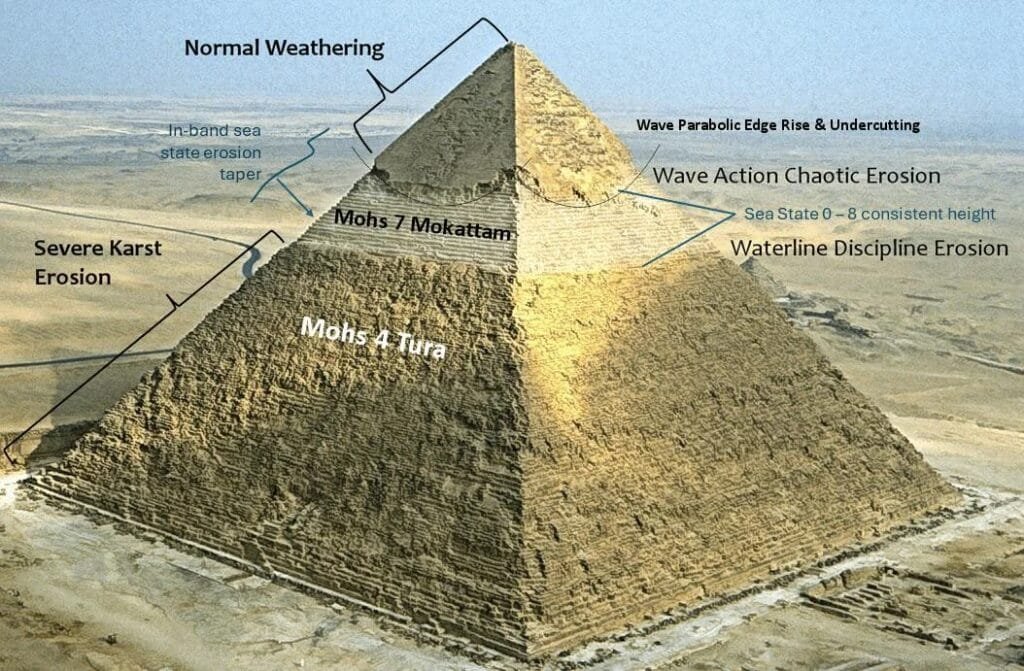Introduction to was the Pyramid Once Underwater?
was the great Pyramid Once Underwater? For years, we’ve been told that the Pyramids of Giza were built around 2500 BCE by the Pharaohs of ancient Egypt. But what if that timeline is completely wrong? What if one of the most famous pyramids—the Khafre Pyramid—was once submerged under the sea? 🌊
Sounds crazy, right? Well, the evidence is there for those willing to look. In this post, we’ll break down the mysterious erosion patterns, explore alternative theories, and ask the big question: were the ancient Pyramid Once Underwater?
The Mysterious Erosion on the Khafre Pyramid
Most people assume that wind, sand, and time are what caused the wear and tear we see on Egypt’s pyramids today. But the Khafre Pyramid at Giza shows a strange type of erosion—one that doesn’t match typical desert weathering. Instead, it looks eerily similar to wave erosion seen on seawalls and ocean structures. 🤯
What Makes This Erosion So Strange?

- The outer casing of the pyramid was once covered in Tura limestone, a type of stone that erodes rapidly when exposed to seawater.
- The erosion follows a curved, parabolic shape, exactly like structures exposed to constant wave action over long periods.
- Some researchers estimate that to create this pattern, the pyramid would have been hit by waves 6–8 feet high—meaning the water level must have been at 576 feet above sea level!
This isn’t just light flooding—this suggests a massive, long-term water event that could rewrite history.
Could Egypt Have Been Underwater? 🌊
If the Khafre Pyramid was once submerged, then we have to ask: How did the water get there? There are a few possible explanations:
1. A Massive Ancient Flood 🌍
Many ancient cultures, from the Bible’s Great Flood to Sumerian and Hindu myths, speak of a cataclysmic flood that reshaped civilizations. Could the pyramids be much older than we think and have survived such a global event?
2. A Different Nile River System 🏞️
Ancient Egypt may have looked very different thousands of years ago. Some researchers believe the Nile River once flowed much higher, turning the Giza Plateau into a partially submerged landscape. Could this have been a lost period in history that mainstream archaeologists have overlooked?
3. An Unknown Civilization 🏛️
What if the pyramids weren’t built by the Pharaohs at all? Some alternative researchers believe that Egypt may have inherited the pyramids from a much older, lost civilization, one that existed before the known dynastic period. If true, the pyramids could be far older than we’ve been told.
Mainstream Arguments: Just Wind and Sand? 💨
Of course, mainstream Egyptologists dismiss these ideas. They argue that the erosion is simply caused by thousands of years of wind and sandblasting. But there’s a problem: wind erosion doesn’t create parabolic wave patterns.
Not to mention, the Great Sphinx of Giza also shows signs of ancient water erosion—which even some geologists have admitted could mean Egypt’s monuments are thousands of years older than we thought.
So, is this really just wind and sand? Or is there something much bigger going on? 🤔
What This Means for History 🏺
If the Khafre Pyramid was truly underwater, it challenges everything we thought we knew about ancient Egypt. Here’s what it could mean:
- The pyramids may not be tombs at all, but rather remnants of a much older, more advanced civilization.
- Egyptian history could stretch back far beyond the 4,500-year timeline we’ve been told.
- Climate changes, rising sea levels, or even massive cataclysms may have wiped out earlier civilizations, leaving only the pyramids as evidence of their existence.
Final Thoughts: What Do You Think was the Pyramid Once Underwater? 🤨
At the end of the day, the evidence is out there for those willing to see it. But the big question is: Are we ready to rethink history?
So, what do YOU think?
- Was the Khafre Pyramid really submerged at some point in history? 🌊
- Could this be evidence of an ancient flood or a lost civilization?
- Or is mainstream archaeology correct—just wind and sand? 💨
Let’s discuss in the comments! And if you found this interesting, be sure to share this post and keep exploring the mysteries of the past. 👁️